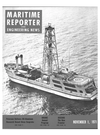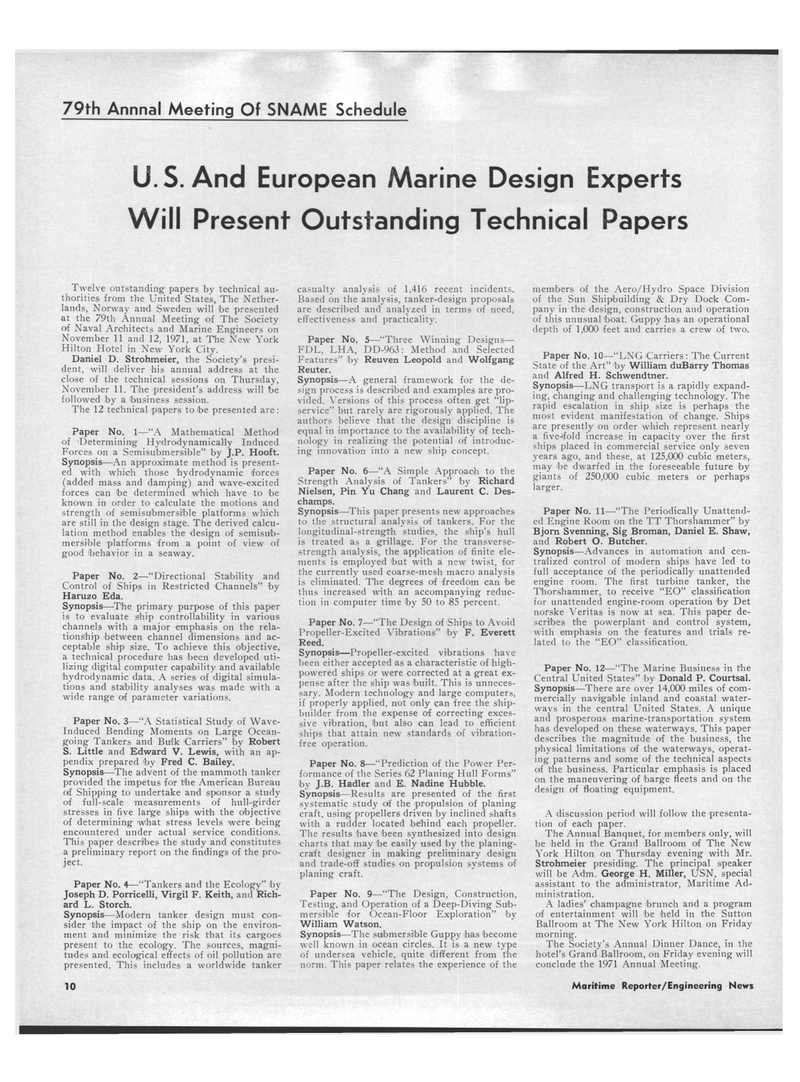
Page 8: of Maritime Reporter Magazine (November 1971)
Read this page in Pdf, Flash or Html5 edition of November 1971 Maritime Reporter Magazine
79th Annnal Meeting Of SNAME Schedule
U.S. And European Marine Design Experts
Will Present Outstanding Technical Papers
Twelve outstanding papers by technical au- thorities from the United States, The Nether- lands, Norway and Sweden will be presented at the 79th Annual Meeting of The Society of Naval Architects and Marine Engineers on
November 11 and 12, 1971, at The New York
Hilton Hotel in New York City.
Daniel D. Strohmeier, the Society's presi- dent, will deliver his annual address at the close of the technical sessions on Thursday,
November 11. The president's address will be followed by a business session.
The 12 technical papers to ibe presented are :
Paper No. 1—"A Mathematical Method of -Determining Hydrodynamically Induced
Forces on a Semisubmersible" by J.P. Hooft.
Synopsis—An approximate method is present- ed with which those hydrodynamic forces (added mass and damping) and wave-excited forces can be determined which have to be known in order to calculate the motions and strength of semisubmersible platforms which are still in the design stage. The derived calcu- lation method enables the design of semisub- mersible platforms 'from a point of view of good behavior in a seaway.
Paper No. 2—"Directional Stability and
Control of Ships in Restricted Channels" by
Haruzo Eda.
Synopsis—The primary purpose of this paper is to evaluate ship controllability in various channels with a major emphasis on the rela- tionship between channel dimensions and ac- ceptable ship size. To achieve this objective, a technical procedure has been developed uti- lizing digital computer capability and available 'hydrodynamic data. A series of digital simula- tions and stability analyses was made with a wide range of parameter variations.
Paper No. 3—"A Statistical Study of Wave-
Induced Bending Moments on Large Ocean- going Tankers and Bulk Carriers" by Robert
S. Little and Edward V. Lewis, with an ap- pendix prepared by Fred C. Bailey.
Synopsis—The advent of the mammoth tanker provided the impetus for t'he American Bureau af Shipping to undertake and sponsor a study of full-scale measurements of hull-girder stresses in five large ships with the objective of determining what stress levels were being encountered under actual service conditions.
This paper describes the study and constitutes a preliminary report on the findings of the pro- ject.
Paper No. 4—"Tankers and the Ecology" by
Joseph D. Porricelli, Virgil F. Keith, and Rich- ard L. Storch.
Synopsis—Modern tanker design must con- sider the impact of the ship on the environ- ment and minimize the risk that its cargoes present to the ecology. The sources, magni- tudes and ecological effects of oil pollution are presented. This includes a worldwide tanker casualty analysis of 1,416 recent incidents.
Based on the analysis, tanker-design proposals are described and analyzed in terms of need, effectiveness and practicality.
Paper No. 5—"Three Winning Designs—
FDL, LHA, DD-963: Method and Selected
Features" by Reuven Leopold and Wolfgang
Reuter.
Synopsis—A general framework for the de- sign process is described and examples are pro- vided. Versions of this process often get "lip- service" but rarely are rigorously applied. The authors believe that the design discipline is equal in importance to the availability of tech- nology in realizing the potential of introduc- ing innovation into a new ship concept.
Paper No. 6—"A Simple Approach to the
Strength Analysis of Tankers" by Richard
Nielsen, Pin Yu Chang and Laurent C. Des- champs.
Synopsis—This paper presents new approaches to the structural analysis of tankers. For the longitudinal-strength studies, the ship's hull is treated as a grillage. For the transverse- strength analysis, the application of finite ele- ments is employed but with a new twist, for the currently used coarse-mesh macro analysis is eliminated. The degrees of freedom can be thus increased with an accompanying reduc- tion in computer time by 50 to 85 percent.
Paper No. 7—"The Design of Ships to Avoid
Propeller-Excited Vibrations" by F. Everett
Reed.
Synopsis—Propeller-excited vibrations have been either accepted as a characteristic of high- powered ships or were corrected at a great ex- pense after the ship was built. This is unneces- sary. Modern technology and large computers, if properly applied, not only can free the ship- builder from the expense of correcting exces- sive vibration, but also can lead to efficient ships that attain new standards of vibration- free operation.
Paper No. 8—"Prediction of the Power Per- formance of the Series 62 Planing Hull Forms" by J.B. Hadler and E. Nadine Hubble.
Synopsis—Results are presented of the first systematic study olf the propulsion of planing craft, using propellers driven by inclined shafts with a rudder located behind each propeller.
The results have been synthesized into design charts that may be easily used by the planing- cra'ft designer in making preliminary design and trade-off studies on propulsion systems of planing craft.
Paper No. 9—"The Design, Construction,
Testing, and Operation of a Deep-Diving Sub- mersible for Ocean-Floor Exploration" by
William Watson.
Synopsis—The submersible Guppy has become well known in ocean circles. It is a new type of undersea vehicle, quite different from the norm. This paper relates the experience of the members of the Aero/Hydro Space Division of the Sun Shipbuilding & Dry Dock Com- pany in the design, construction and operation of this unusual boat. Guppy has an operational depth of 1,000 feet and carries a crew of two.
Paper No. 10—"LNG Carriers : The Current
State of the Art" by William duBarry Thomas and Alfred H. Schwendtner.
Synopsis—LNG transport is a rapidly expand- ing, changing and challenging technology. The rapid escalation in ship size is perhaps the most evident manifestation of change. Ships are presently on order which represent nearly a five-tfold increase in capacity over the first ships placed in commercial service only seven years ago, and these, at 125,000 cubic meters, may be dwarfed in the foreseeable future by giants of 250,000 cubic meters or perhaps larger.
Paper No. 11—"The Periodically Unattend- ed Engine Room on the TT Thorshammer" by
Bjorn Svenning, Sig Broman, Daniel E. Shaw, and Robert O. Butcher.
Synopsis—Advances in automation and cen- tralized control of modern ships have led to full acceptance of the periodically unattended engine room. The first turbine tanker, the
Thorshammer, to receive "EO" classification for unattended engine-room operation by Det norske Veritas is now at sea. This paper de- scribes the powerplant and control system, with emphasis on the features and trials re- lated to the "EO" classification.
Paper No. 12—"The Marine Business in the
Central United States" by Donald P. Courtsal.
Synopsis—There are over 14,000 miles of com- mercially navigable inland and coastal water- ways in the central United States. A unique and prosperous marine-transportation system has developed on these waterways. This paper describes the magnitude of the business, the physical limitations of the waterways, operat- ing patterns and some of the technical aspects of the business. Particular emphasis is placed on the maneuvering of barge fleets and on the design of floating equipment.
A discussion period will follow the presenta- tion of each paper.
The Annual Banquet, for members only, will be held in the Grand Ballroom of The New
York Hilton on Thursday evening with Mr.
Strohmeier presiding. The principal speaker will be Adm. George H. Miller, USN, special assistant to the administrator, Maritime Ad- ministration.
A ladies' Champagne brunch and a program of entertainment will be 'held in the Sutton
Ballroom at The New York Hilton on Friday morning.
The Society's Annual Dinner Dance, in the hotel's Grand Ballroom, on Friday evening will conclude the 1971 Annual Meeting. 10 Maritime Reporter/Engineering News

 7
7

 9
9
